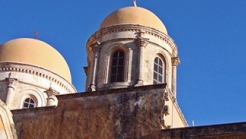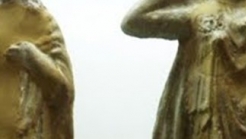

Greece
The Amfiareio was the biggest ancient Greek sanctuary of the vile god and hero of Argos Amfiaraos. During its’ operation, it was the national sanctuary of Oropos, one of the oldest cities in Ancient Greece.
The Oropos Amfiareo lays in a small valley southwest of Oropos. The Amfiareio was the biggest ancient Greek sanctuary of the vile god and hero of Argos Amfiaraos. During its’ operation, it was the national sanctuary of Oropos, one of the oldest cities in Ancient Greece. It was founded in the end of the 5th century BC, when Oropos was under Athenian rule.
As a port, Oropos was being claimed by the Boeotians and the Athenians. Around 506 BC, following the victorious excursion of Athenians against the Boeotians or a little after the Persian wars, Oropos came under Athenian rule. A speech of the ancient orator Lysias, testifies that Polystratos the Athenian was the commander of Oropos from 411 BC.
The time from 338 BC to the beginning of the 3rd century BC, is a time of various changes. Philip the Macedonian or his son Alexander, give Oropos to the Athenians. The Athenians restructure the festivities and the games of the temple, give offerings to Amfiaraos and construct buildings. In 313 BC, Oropos is conquered by Ptolemeus, general of Antigonos the One-Eyed. In 287 BC, Oropos becomes a member of the Common of Boeotia, and what follows is a flourishment of the Amfiaraeon that lasts until 146 BC. Its temple is now a meeting point of scores of people from aroung the Greek world, the islands and Asia Minor. The temple receives many offerings and sponsorships. The ports –Skala and Delfino as are their names today- where the visitors disembarked contribute to the increase of Oropos’ income. Great monarchs from the East, such as Ptolemaeus IV contribute to the small state.
During the Roman times, (from 146 BC) Oropos is self sustained. The blooming of the temple during the 1st century BC is due to τηε Ρομαν γενεραλ Συλλας, a major benefactor. In the beginning of the 1st century BC, during the times of Augustus, Oropos is finally a domain of Athens. Writings of the first christian times found in the Amfiaraeon, inform us on the Athenian offerings to the temple’s worshipped god. Followin the domination of Christianity, the temples pilgrimage died away.
In 1884 the systematic dig of the temple started, under the Archeological Company’s guide, with Vasileios Leonardos. The dig lasted until 1929 with some breaks between, and unearthed the remains of buildings in Mavrodilesi and many writings, valuable considering the information they contain.
The Amfiaraeon is built on the edge of a stream, Charadra as it was named by the Ancients. On the left bank are situated the formal buildings, the temple, the arcade, the altar, the theater, and on the right bank is the living quarters. On the living quarters, apart from offices, shops and hotels, were the market and Klepsydra (a hydraulic clock). Nowadays, the remains of the temple’s buildings can be seen.


The Inscription Museum is unique in Greece, and the largest of its kind in the world. In it there are 13.536 inscriptions, mostly written in Greek. Chronologically, they cover the times from the first historic times to the paleochristianic, and most of them come from Greece.


The Monastery of Agia Triada of Τzagkarolon was built in the early 17th century by wanne Ιeremia and Larentio,venetian-cretan family of Τzagkarolon in smaller, property of hieromonk Joachim and Sofianou.


The Museum of European Border Guard Corps of Europe was created from the Folklore Center Academy of Athens in Paleochora Chania.
1039 Ε 6061 01515 00